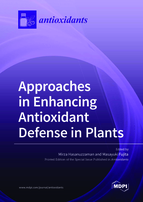Approaches in Enhancing Antioxidant Defense in Plants
A special issue of Antioxidants (ISSN 2076-3921). This special issue belongs to the section "ROS, RNS and RSS".
Deadline for manuscript submissions: closed (31 December 2021) | Viewed by 74972
Special Issue Editors
Interests: plant stress physiology; plant biochemistry; abiotic stress
Special Issues, Collections and Topics in MDPI journals
Interests: antioxidants; abiotic stress tolerance; plant metabolites; ROS signaling
Special Issues, Collections and Topics in MDPI journals
Special Issue Information
Dear Colleagues,
As a sessile organism, plants always face various abiotic and biotic stresses which are major threats to sustainable crop production and the most important obstacle for attaining food security. In addition to their many detrimental effects, they lead to oxidative stress through the overaccumulation of reactive oxygen species (ROS). A certain steady-state of ROS (1O2, O2•−, H2O2, and •OH) is maintained by properly balancing the generation and elimination of ROS through finely regulating a defense system in plants. Plants primarily deal with oxidative stress through their own defensive mechanism, which consists of different enzymatic and non-enzymatic antioxidants. Non-enzymatic antioxidants include ascorbic acid (AsA), glutathione (GSH), phenolic compounds, alkaloids, α-tocopherol, non-protein amino acids, etc. These molecules either scavenge or detoxify ROS and confer stress tolerance in plants. In recent decades, plenty of research has focused on the role of different non-enzymatic antioxidants in the mitigation of oxidative stress, and the results of these studies are being applied to crop plants. In this Special Issue, we aim at publishing research articles and reviews on research focused on antioxidant defense, which will serve as a foundation for plant oxidative stress tolerance.
Prof. Dr. Masayuki Fujita
Prof. Dr. Mirza Hasanuzzaman
Guest Editor
Manuscript Submission Information
Manuscripts should be submitted online at www.mdpi.com by registering and logging in to this website. Once you are registered, click here to go to the submission form. Manuscripts can be submitted until the deadline. All submissions that pass pre-check are peer-reviewed. Accepted papers will be published continuously in the journal (as soon as accepted) and will be listed together on the special issue website. Research articles, review articles as well as short communications are invited. For planned papers, a title and short abstract (about 100 words) can be sent to the Editorial Office for announcement on this website.
Submitted manuscripts should not have been published previously, nor be under consideration for publication elsewhere (except conference proceedings papers). All manuscripts are thoroughly refereed through a single-blind peer-review process. A guide for authors and other relevant information for submission of manuscripts is available on the Instructions for Authors page. Antioxidants is an international peer-reviewed open access monthly journal published by MDPI.
Please visit the Instructions for Authors page before submitting a manuscript. The Article Processing Charge (APC) for publication in this open access journal is 2900 CHF (Swiss Francs). Submitted papers should be well formatted and use good English. Authors may use MDPI's English editing service prior to publication or during author revisions.
Keywords
- plant stress
- reactive oxygen species
- ascorbic acid
- glutathione
- tocopherol
- metatonin
- aminoacids
- oxidative stress
- antioxidant defense
- phenolics








